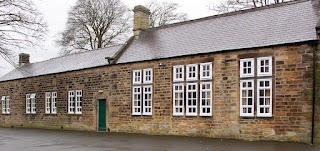A Childhood Spent in the Village of Dore
Growing Up on Causeway Head Road
Stuart’s earliest memories are when he was about three in 1945. The last vestiges of war were apparent. His back garden was full of vegetables as were those of his neighbours. There was an Anderson shelter in the garden which was a great place to play with his friends. The black curtains of the enforced blackout were still used in his house for some time.
They lived in 94 Causeway Head Road and he looks back at the facilities they had. A refrigerator must have been a luxury he realises now. The family had a car from 1947, which was unusual. The house was surrounded by fields, with cows grazing, and he would spend his early years playing in these fields or cycling around the roads on his tricycle.
This early photograph, taken before the development of Dore, shows Limpit Cottage on Causeway Head Road.
Note the lamp post and the sycamore tree.
Here is the same cottage, lamp post and sycamore tree in the 1960s. It is at the junction of High Street and Causeway Head Road.
The cottage and tree are still there today.
During the war years his mother Jean Dunn, née Rhodes, had a Canadian or American soldier (he cannot remember which) billeted in their house. His father, John, had been in the Royal Navy and did not come home until 1947, as he was involved in the war with Japan and its aftermath.
He remembers Causeway Head Farm buildings before the main development around Causeway Head Road. The main entrance to the farm was at the junction of Causeway Head Road and Parkers Lane. Causeway Head Road was marsh to the side towards Rushley Road. In 1947/8 the land was drained and pre-fabs were built.
On the opposite side of the road from Stuart’s house there was Causeway House where one of his friends lived, a very grand building owned by the steelmaker, Eldon Lee of Arthur Lee & Sons. This house was demolished to make way for Hassells housing development and only the coach house remains now as an individual dwelling.
From number 94, the family moved to 29, Causeway Head Road, White Corners, that was once a Barnardo’s Children’s home and then a home with an internal doctor’s surgery. After the family moved in the doctor’s surgery and other rooms continued to be rented by Dr Exell from them.
Education - the Early Years
He started going to Miss Trott’s preschool class in the Church Hall just after the war ended. This was held in the back rooms of the hall, now Christ Church Dore Community Centre. Sunday School was held in the same place and was extremely popular. A chance to meet with all the other children of the village.
At 5 years of age he started formal education at Dore School in the Old School buildings. He always walked to school on his own or with friends. There were very few cars and a few on horseback in the village.
Later Stuart (aged 7 years) went to Birkdale School in Sheffield and remembers getting the bus from Dore unless it was snowing. The bus went as far as Ecclesall tram terminus where he had to get a tram into town.
Visiting Dore Hall Farm
Uncle Joseph Denniff and his wife Auntie Connie were farmers at Dore Hall Farm. There were two entrances, one from Vicarage Lane, one on Dore Road about 150 yards below the junction of Causeway Head Road and Dore Road, with a cobbled driveway and side stone paved area, leading to the farmhouse. There were times when lunch was not available at home and Stuart made his way to the farm.
His aunt would feed all the farm labourers, about 15 in total, around a long refectory table with benches either side. The sights and smells of that kitchen are imprinted on his mind. It was always warm and a broth or meat and two veg was on offer. There was a large black Yorkshire range with a black pot for the stewed meat or broth and a black kettle. Fresh bread from the baker and grocer, Huby Frith, was a welcome addition. Adjacent to the kitchen was a scullery where Connie would prepare food.
The house itself was four or five bedrooms and well furnished, although he only got to see it once, as he was only allowed in the kitchen. Stuart explains everyone in the village knew him, same as with the other children, and people looked out for them all. His grandparents, Sydney (a scrap metal merchant) and May Rhodes (née Denniff), also lived around the corner in White Lodge, Church Lane. Dore Hall Farm was demolished in the later 1950s and its land used for housing development.
Childhood Interests
The interests of the boys of Dore during the 1940s and 50s were similar to the subsequent generation; football, cricket and scouting. He would go and watch county cricket with his father, at Bramall Lane.
He was also a choir boy at Christ Church and attended choir practice once a week.
Then in 1960, at the age of 17, he got his first job serving petrol at Dore Garage.
Being brought up in Dore was certainly a good introduction to life, and the world of work for Stuart.








No comments:
Post a Comment
Please leave message if you have more information or would like to make a correction or ask a question. We would love to hear from you.